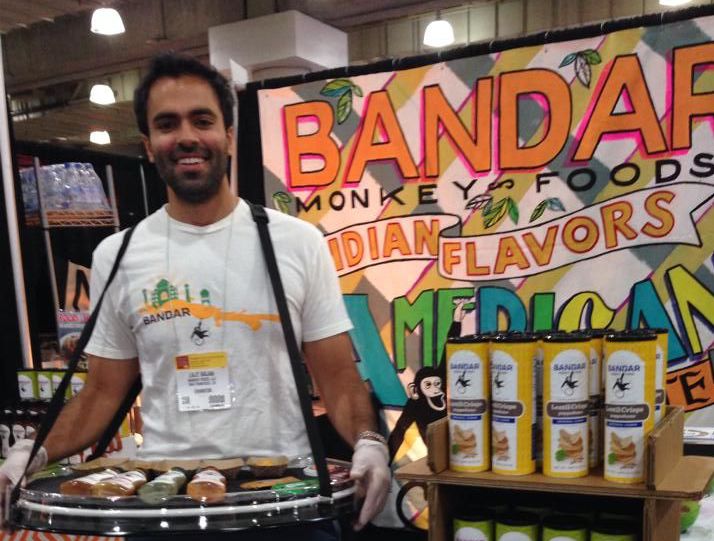Secret Sauce: 10 Tips for Getting Your Product into Whole Foods is a guest series by the founders of Bandar Foods. Follow along as Dan and Lalit share their tips and tricks for starting and growing a specialty food company.
Congratulations – you made it into some stores – maybe even Whole Foods! While rightly patting yourself on the back for the huge accomplishment, you suddenly feel even more stressed. One of the biggest misconceptions of the food world is that life is easy once you get accepted into the big chains. Nope. The larger challenge is getting customers to consistently buy your product off the shelf. For the same reasons you were able to convince the store buyer to replace an existing product with your product, there is a huge line of companies wanting your spot. The best (and in many cases, only) way to keep your space is to be a top seller in your category. The good news is you have some tools at your disposal including running promos, demos, or other events to build your in-store sales. But hurry, the clock is ticking until the buyer’s next review cycle!
Evaluating Sales Velocity
For entrepreneurs, the most common metric to evaluate how your brand is performing is the number of units sold per store per week (“UPSPW”). This is done for each one of your SKUs – so Grandma’s Marinara Sauce can be moving 3 UPSPW, while the Pomodoro is moving 5 UPSPW in any given store. The key for you is to ensure you’re moving well compared to your category.
The rule of thumb is that aisles on the perimeter of the store (produce, meat, dairy, perishable, etc) have much higher sales velocities than the dry grocery aisles in the center of the store. Milk is typically on more people’s grocery shopping lists than sardines. Buyers typically compare product sales velocities to their respective category. So, as a pasta sauce, Grandma’s brand will typically only be judged against the rest of pasta sauce category, rather than against soda. Selling well will earn you larger and more valuable shelf space – or the opportunity to get more of your SKUs on the shelf. Not selling well puts your brand on the chopping block during the review cycle.
Getting sales data can sometimes be tricky. Some retailers (like Whole Foods) are very good at providing this data for their vendors. Others do not easily provide this information, or you might need to spend money on industry reports. Try and purchase whatever data you can afford; an analytical approach to your business is vital. When you’re larger, you’ll better be able to afford syndicated data from Nielsen or IRI who track across stores nationwide. However, for your small brand, the simplest bet is to try and build a great relationship with your buyers and see if they can let you know how you’re performing, and whether you’re meeting expectations for the category.
Tools to Improve Velocity
Every food brand, small and large, is doing whatever they can to improve their sales velocities. Larger brands with big budgets can afford TV commercials and giant displays in the store. It’s tough to compete with that, but small brands have a number of resources to help grow their sales. Next week we’ll talk about improving overall brand awareness. This week, let’s discuss tactics to execute within the store.
- Temporary Price Cuts: Put your product on sale and get a colorful tag with the lower price to catch people’s eye. Typically, reducing your price by 15-20 percent can improve your turns. You might need to provide deeper price cuts in more competitive categories. For example, cereal, chips, beverages and ice cream brands often need to rely on 30 percent cuts, up to buy-one-get-one free (50 percent). This will reduce your margin, but could be worth it to earn your sales volume. Think of how many products you buy exclusively because they’re on sale.
- Sampling and Demos: Be nice to those people offering free samples. In-store demos are one of the most effective ways to get potential customers to try your product directly. Some stores will allow you to to provide in-store samples yourself, and others want to use their own people. Either way, make sure to convey clear selling points with as much enthusiasm as possible. “Try a free sample?!”
- Coupons: Typically a discount as small as $1 off is effective at increasing brand awareness. Keep in mind that millennials don’t collect coupons the same way baby boomers, so know your audience and whether this could be an effective route.
- Advertisements: Buying space in the grocery’s circular can sometimes improve attention to the brand, or it can be a huge waste of money. Experiment and see if this works.
- General Merchandising: As a small brand, your products may get pushed around on the shelf and not look right. Maybe your label will be accidentally turned around, or a dirty jar is front facing. This will hurt sales. Regularly visit your stores and spruce up your product display yourself. Also, try being really nice to your buyer and see if you can get even better shelf space.
At the end of the day, your packaging will be the best selling point in any store. Think of how many times you bought a product purely because you thought the label was cool. Regularly revisit and invest in your packaging – this will be your best billboard.
Don’t miss the earlier posts in our Secret Sauce series!
- Secret Sauce: 10 Steps to Getting Your Product into Whole Foods (Intro)
- 10 Steps to Getting into Whole Foods: #1 Ensuring Your Product Is Sellable
- 10 Steps to Getting into Whole Foods: #2 Can Your Recipe Scale?
- 10 Steps to Getting into Whole Foods: #3 Develop a Standout Brand
- 10 Steps to Getting into Whole Foods: #4 Finding Product-Market Fit
- 10 Steps to Getting Into Whole Foods: #5 Understanding The Players
- 10 Steps to Getting Into Whole Foods: #6 Setting Up Admin
- 10 Steps to Getting Into Whole Foods: #7 Crunching Numbers
- 10 Steps to Getting Into Whole Foods: #8 Start Selling!






